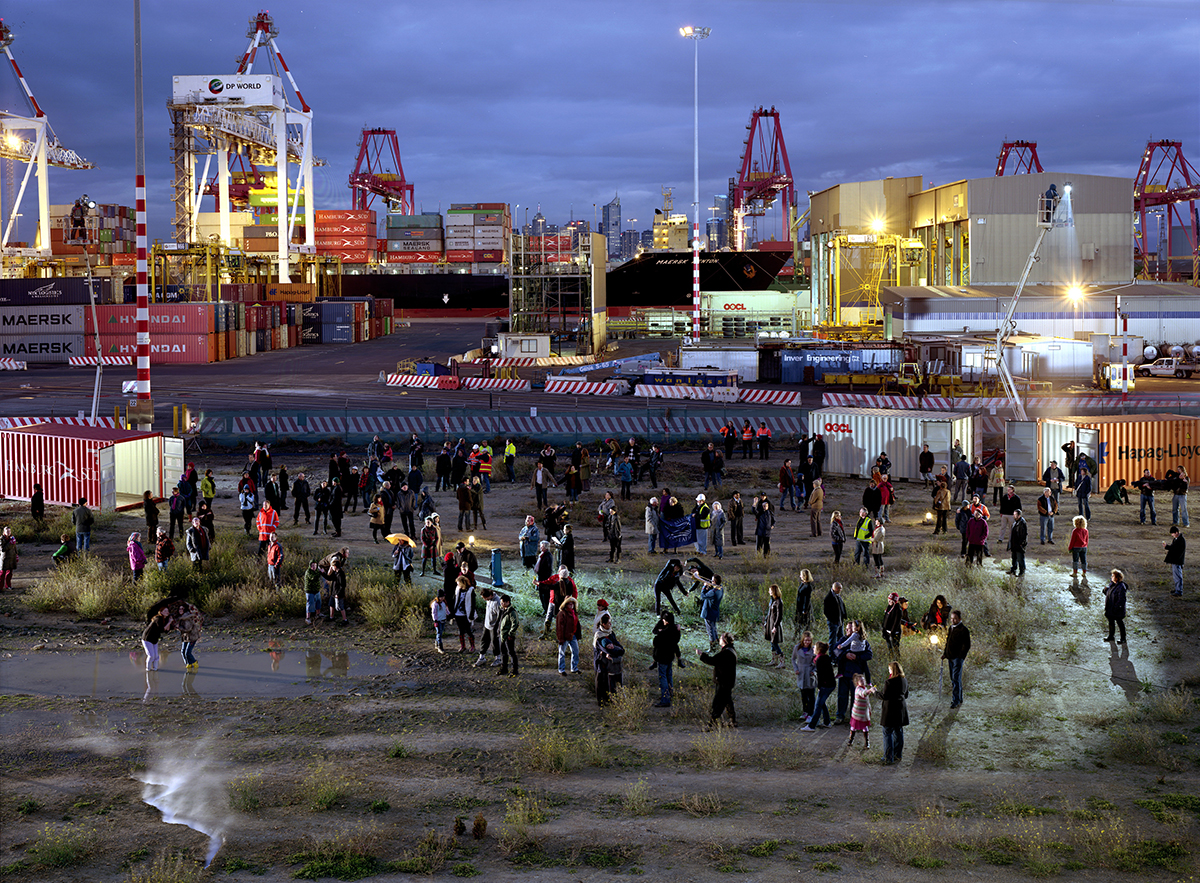
The spirit of the place: 8 years of writing for RealTime
I wrote around 40 reviews for RealTime between late 2008, when I was finishing a grad dip. in journalism, and early 2016, when a bicycle crash changed the shape of both my left hand and my working life — though, thankfully, not permanently. In that time, I accepted RealTime commissions that exposed me to singing sausages [Heart of Gold The Musical, RT94] and ‘cyberdada’ [Cyberdada Retrospective, RT110], cocktails made of snail foam [Wilderness Adventures for the Palate, RT107] and high Romanticism with animal costumes [NDINAVIA, RT89] — all in the service of documenting Australian hybrid and experimental arts.
What ties all these articles together? Ruminating at length on this, I finished up with two threads: my abiding interest in how we inhabit, explore and generate places and their atmospheres; and, obviously but not insignificantly, a habitual commitment to ‘saying yes’ to whatever Keith and Virginia asked me to do. So, below, some organising of the resulting ‘landscape’ — a three-part reflection on works that took me places, metaphorically and literally; immersed me in atmospheres both environmental and digital; and carved out spaces for both the marginal and the personal.
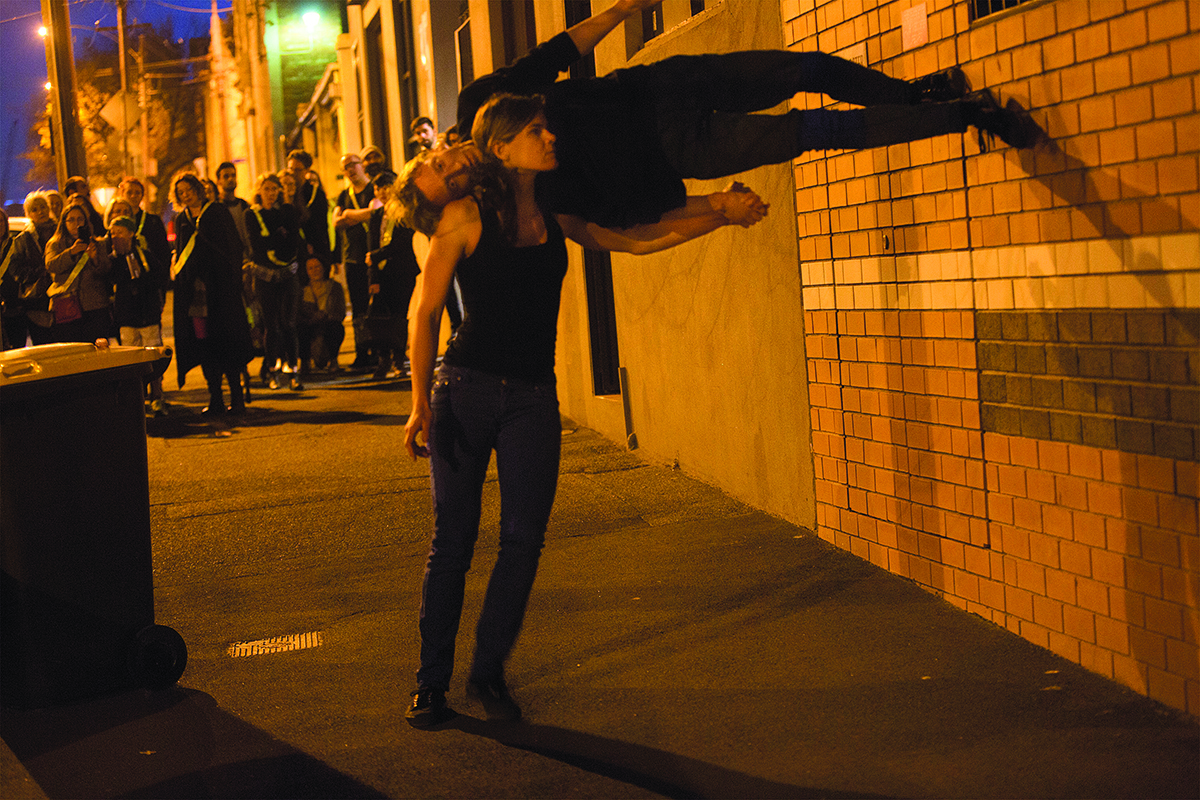
Naomi Francis, Skye Gellmann, Bodies over Bitumen, photo Ponch Hawkes
Place/space/ritual
Taking up space, messing with and re-presenting it, site-specific works are both demarcations and modifications. At Melbourne Fringe 2015, Skye Gellmann, Naomi Francis and Alex Gellmann took their circus skills into the back streets of North Melbourne in a subtle, fugal reclaiming of the built environment, Bodies over Bitumen RT [130]. “With histories spanning homelessness, squatting and street daredevilry, [the] creators are credentialled with lived understandings of space and who it belongs to, as well as how to claim and disrupt it. With a shared language born of past collaborations, they create a mood sometimes of aimlessness, sometimes of interrupted purpose, and equally of experimental occupation.” From virtuosic pole work (on a parking signpost) to “space-eating” aerials and a nerve-racking scene in which the performers lay spread-eagled on the road in “a poetic and visceral pause,” Bodies over Bitumen took purposeful ownership of the site; walls, fences, roundabouts, tarmac and all.
Intervening rather than occupying, Gabriella Mangano and Silvana Mangano’s Hidden Spaces, Ready Stages [RT116] seemed to attempt to turn bodies into space, as the artists explored and exposed the labyrinthine recesses of Melbourne’s Arts Centre. Large video screens set inside the cavernous, raw-concrete shell of the Arts Centre’s Riverhouse displayed vents, pipes, tunnels and columns, in which human figures appeared almost “as if…trying to ‘be’ the space.” James Brown’s groaning, clanging, pulsing soundtrack felt both industrial and “uncannily evocative of nature,” by turns “palpating the air” and “seemingly sucked down through the vents from foyer to pit to boiler-room.” Hidden Spaces, Ready Stages “inserts the human into the void, the artists spelunking into spaces designed never-to-be-seen-or-heard,” as these bodies attempted to meet the “impenetrable (though now-penetrated) edifice.”
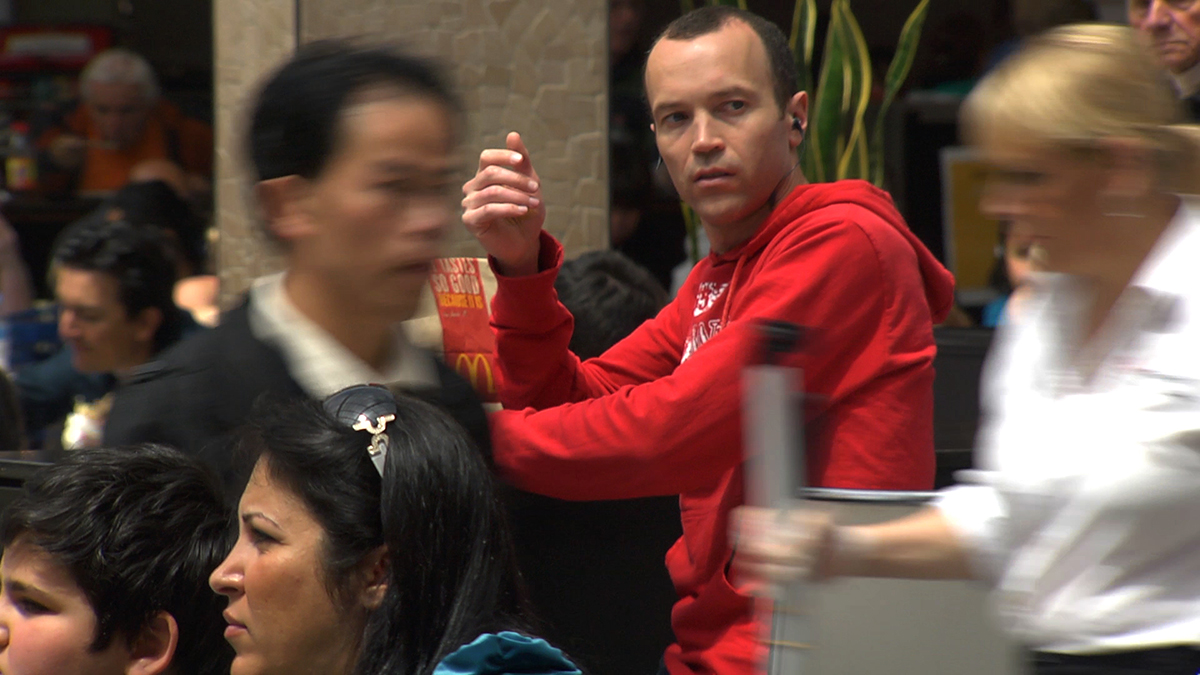
Tom Davies, PUBLIC, concept/direction Tamara Saulwick, video still courtesy the artists
Sound was a crucial element in the transformation of another cavernous space — the Highpoint Shopping Centre food court, in Melbourne’s inner west — when Tamara Saulwick, with sound designer Luke Smiles, presented PUBLIC, also in 2013 [RT119]. Issued with closed headphones, audience members were sent into the food court, where the soundtrack – partly live and partly pre-recorded – provided clues to where each of four performers moved. We eavesdropped as they came together to talk about chatbots, girls getting engaged and guys on late shifts…with the dance track “I Feel Love” providing a steady, heady backbeat. “Hundreds of unpaid extras” added their noodle-slurping, ice-cream-licking, napkin-crumpling gestures to the scene, “the rhythms of banal exchange [elevated] to the level of music or poetry.” And yet, despite an increasingly surreal feeling as the performers’ actions escalated, “the work strikes me as almost ‘representational’ — ‘depicting’ the space, if you will, in larger-than-life tones.” Place and people, public and private all merged; location and community still felt strangely fused well after the ‘performance’ was over.
Zoe Scoglio’s MASS, part of Field Theory’s Site is Set 2015 [RT129], extended ‘location’ to take in the cosmos, transforming the crumbling Calder Park Raceway into an auditorium fit for a ritual reflection on consumption, connection and our place in the universe. MASS centred our attention on cars — in Scoglio’s words “metal shells, fleshy inside, shiny outside, fossil-fuelled,” under a rising full moon. Sixty carloads of spectators followed an ‘Order of Service’ that included choreographed parking on a shabby backblock, and an ascent and descent of the raceway embankment on foot to view weed-covered seating banks on one side and darkening city skyline on the other. Via a soundscape played on car radios and through mobile headphones, we were indoctrinated on our “anthropogenic impact” and our relationship to the rocks of the earth itself. At the height of the ritual, “[s]winging censers exhale clouds not of frankincense, but the scent of burning rubber. As MASS ends, we’re reminded of our collective intimacy: we are connected, geological objects whose mutual gravitational pull will now begin to weaken.”
Gatherings make spaces
If places generate atmospheres in and of themselves, gatherings held at particular places/times overlay and expand them, their fleeting energies temporarily releasing ephemeral genius loci of various kinds. At themed events like the first Channels Video Art Festival [RT118], SymbioticA’s Body/Art/Bioethics Symposium [RT99], the Asian Producers’ Platform Camp in Seoul [RT125] and Curtin University’s 2010 symposium and exhibition, Art in the Age of Nanotechnology [RT96], discrete convergences of time/place were steeped in experimentation, provocation, collaboration and simulation, respectively.
Art in the Age of Nanotechnology, in particular, immersed visitors in the super-high-technology of nanoparticles, observed, harnessed and explored in artworks that included Victoria Vesna and James Gimzewski’s hypnotic Nanomandala. To create the work, monks from the Tibetan Gaden Lhopa Khangtsen monastery in India worked full-time for a month building a richly coloured sand mandala, which Vesna and Gimzewski then photographed at various scales, including with a Scanning Electron Microscope. The result is a seamless, slowly zooming projection that conveys viewers, over 15 minutes, from the “intricately rendered geometric patterns, human figures, tiny creatures and curling clouds” of the mandala towards “ever-growing grains of brightly coloured sand…a micro-landscape of boulders and edges, before the rich hues fade and we begin to ‘see’ at the nano-level — a scale at which colour itself ceases to exist and the sandscape becomes flakes and mounds of rippled grey and white” [RT96].
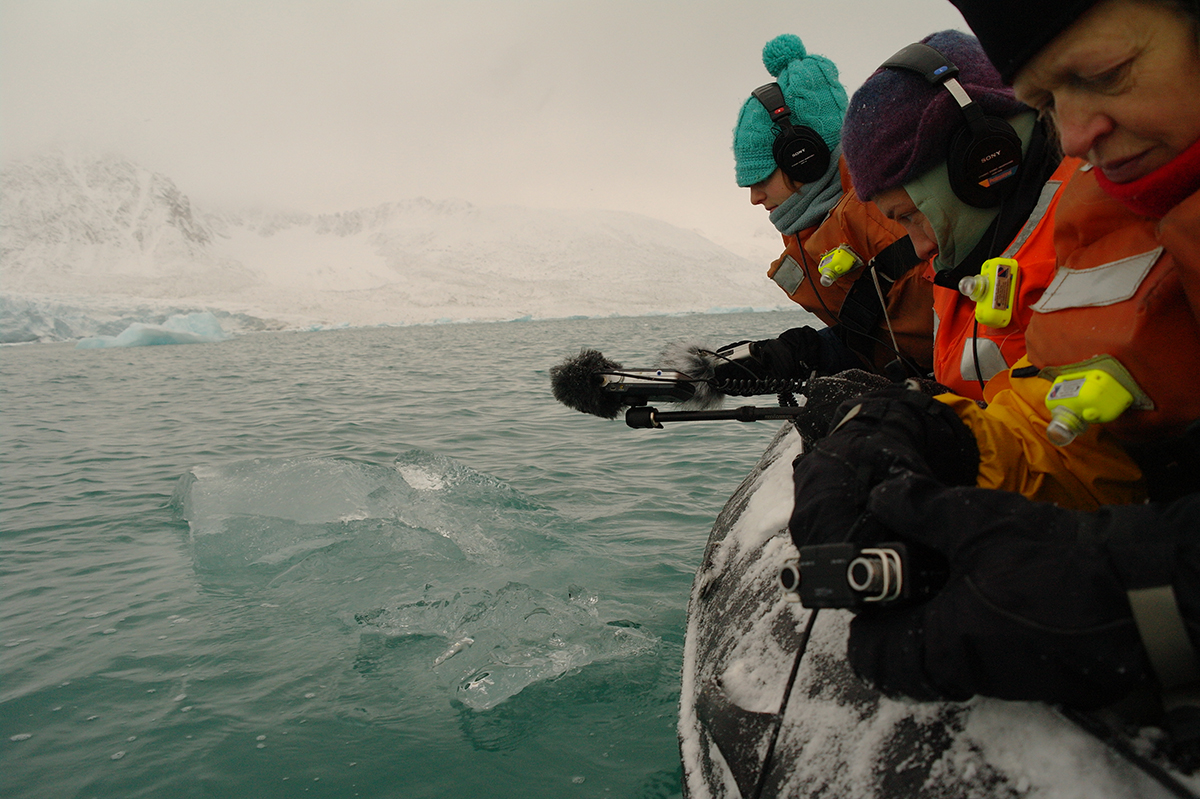
Interviewing ice, Arctic Circle Artist Residency, photo courtesy the artists
Later in 2010, I was lucky enough to take part in The Arctic Circle international artist residency, logging a report for RealTime from high-Arctic Svalbard [RT100], where 20 artists gathered to make sense of a place that seemed boundless and remote in the extreme. On-the-ground interventions (at times in thigh-deep snow) included Rebeca Mendez’s staking of a territorial claim for Mexico via a hapless, flag-posting ‘explorer’; Chad Stayrook’s ubiquitous appearances with foolishly gigantic cardboard ‘survey tools’; Carrie-Ann Bracco’s intrepid plein-air oil painting sessions, often undertaken amid blizzards; and Teng Chao-Ming’s marking out of an apartment-sized ‘home’ in the uninhabited ‘Advent City’, an utterly deserted mining town at around 78° North.
But of all the gatherings that ‘made place’ for me in short-lived but impactful ways as a RealTime writer, Sydney’s hosting of the international 19th Symposium on Electronic Art (ISEA) in 2013 topped the bill. With many dozens of exhibitions, performances, public talks and workshops, and what must have been hundreds of participating artists, ISEA 2013 seemed to amp up inner Sydney’s already high voltage: a creeping network of events that included myriad subsidiary place-makings in the form of themed group exhibitions — like ANAT’s Synapse: A Selection [ISEA-in-RealTime blog, 11 June 2013] and SymbioticA’s bio-arts-focused semi-permeable (+) [ISEA-in-RealTime blog, 10 June 2013], both at Powerhouse; as well as smaller shows like Echosonics [ISEA-in-RealTime blog, 14 June 2013] — an exploration of sound and environment — and the more esoteric If a system fails in a forest… [ISEA-in-RealTime blog, 17 June 2013].
Amid machinic, scent-producing ‘flowers’ [ISEA-in-RealTime, Gail Priest, 13 June 2013], a ‘Twitter meets the book arts’ cutting-and-pasting project [ISEA-in-RealTime, 16 June 2013] and a Skyped-in keynote address from Julian Assange [ISEA-in-RealTime blog, 14 June 2013], two works — one grand, one necessarily intimate — continue to resonate within the expansive ‘place’ that I remember as ISEA Sydney: Ryoji Ikeda’s seductive and profound datamatics (ver. 2.0) [ISEA-in-RealTime, 8 June 2013] and George Poonkhin Khut and James Brown’s Theta Lab [ISEA-in-RealTime, 13 June 2013].
Ikeda’s video work datamatics (ver.2.0) was “[a] near-monochrome diamond-cut of ones and zeros flying faster than the eye can grasp; an hour of heartbeat-paced, Morse-toned pips and subliminal surges.” “[B]lack screen, white bars, barcodes, churning letters and numbers, an infinite, ever-changing scroll of data” morph into spatial landscapes: “a mapped-out universe whose anonymous stars are sequentially named and positioned…What emerges from it is a profound representation of the impact of mathematics on the world, the endless grid of ‘knowledge’ that positions everything from clustering stars to swarming starlings.” In datamatics (ver.2.0), location existed in brilliant coordinates, as an architecture both minutely drawn and infinite in scope, “an almost tangible spatial realm between the data and its representation.”
To call Theta Lab an insight into ‘place’ is a stretch, admittedly; the ‘place’ experienced was the mind itself. “[A] real-time interaction between participants’ brainwaves and a responsive soundscape”, Theta Lab took place on a futon-like bed, in a darkened ‘pod’ that felt “like a monastery or a health retreat, minus the whale music.” Wired to an EEG monitor, my mission was to relax; my changing brainwave patterns — ideally producing what are called Theta waves —influencing a responsive soundtrack. The experience was “challenging, illuminating and intensely interactive…It’s just me and the neurofeedback system: a half-hour mental dance of confidence, calm, impatience, frustration, surprise, wonder and occasional self-punishment.” The resulting sounds, far from indicating inner calm, ranged from “a constant, throbbing murmur that travels through my whole body, to bell-like tones that seem to call a higher consciousness…[a] loud crackle…[and] beating bass tones… [A]t the end, feeling a little like I can’t drum up a Theta wave to save myself, I can only think, wow, is that what it’s like inside my head?”
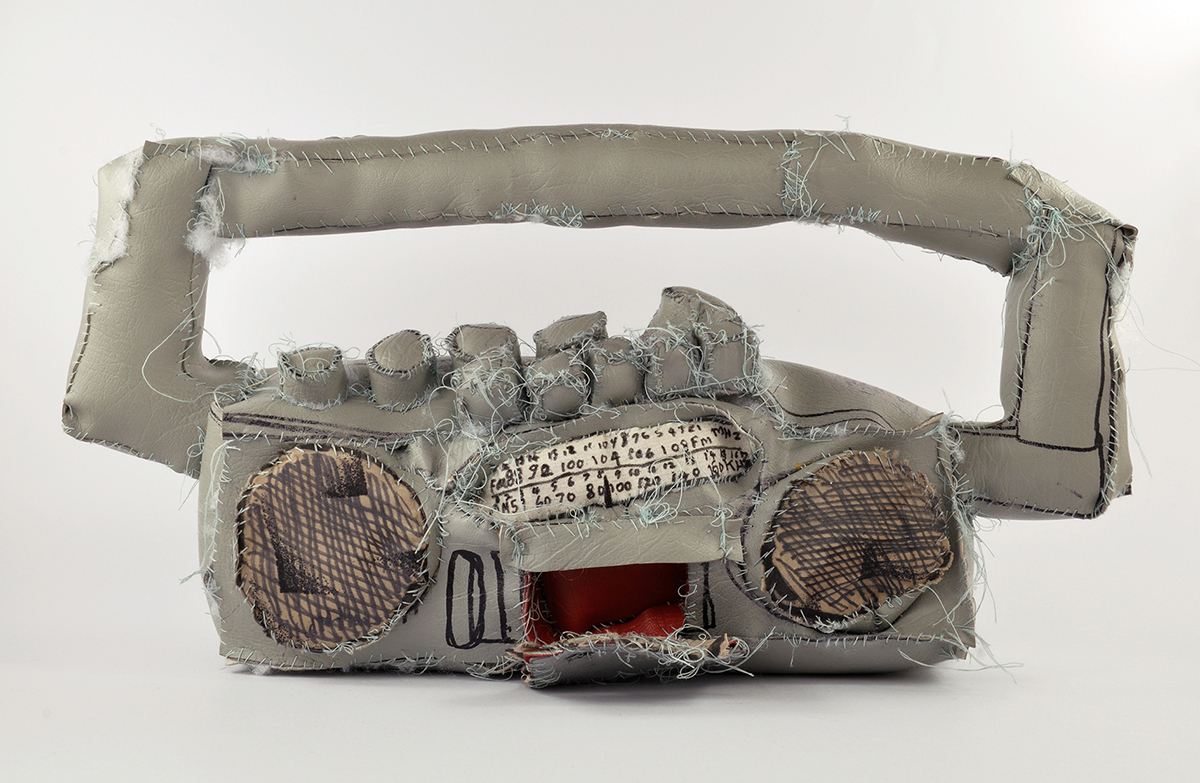
Stereo 2011, Terry Williams, private collection Melbourne, photo courtesy the artist
Carving out a place
Some of the most gratifying artistic ‘spaces’ are those that privilege the intimate, the personal and the marginal. For Everyday Imagining: New Perspectives on Outsider Art at the Ian Potter Museum of Art [RT125], curator Joanna Bosse brought together seven ‘outsider artists’ — so named as part of a tradition that has “embrace[d] the art of makers variously perceived as untrained, self-taught, intellectually or physically disabled, or otherwise marginalised from either mainstream society and/or the mainstream art world.” Paradoxically carving out a place ‘inside’ the art establishment, via this very status as ‘outside,’ these artists explored “the same everyday world that we all live in: a world of things, people, obsessions, doodlings, abstractions, patterns and geographies.” Their renderings ranged from uncannily accurate re-creations of household objects as fabric sculptures to intricate, flawlessly executed, hand-drawn patterns on graph paper that “shimmer like snowflakes or starfields.” They made new spaces as artworks always do: “shaping form out of chaos (see Elizabeth Grosz’s Chaos, Territory, Art); exploring representation, abstraction, topography.”
In Amelia Ducker and St Martins’ Genius [RT131], a group of children often labelled similarly as ‘outsiders’ — all on the autism spectrum – invited audiences into purpose-built, circular booths where they shared their expert knowledge and skills with their visitors, on topics as diverse as endangered Australian animals and the rhetoric of Gough Whitlam. In Genius, “the predictability of the format supports the possibility of our interaction; we are asked to [the creators’] worlds on their terms, not ours.”
The first work I reviewed for RealTime was Simon Terrill’s Crowd Theory – Port of Melbourne [RT87], a large-scale, community-focused photo shoot in which a ‘crowd’ formed by “locals, interested ‘outsiders’, port workers…and sundry others” got to “stake its tenuous claim…behind the wire fences.” The last was young Palestinian-Australian artist Aseel Tayah’s you are not a boy [RT131], a short outdoor performance in which Tayah told stories of women “mutilated, verbally abused, chastised or prohibited from speaking out” because they were ‘not a boy,’ while pinning squares of fabric inscribed with the Arabic word for ‘taboo’ onto onlookers’ clothing. Saying ‘yes’ to these and so many other commissions, over almost a decade, meant participating in worlds, and sometimes being drawn into making them: transformed sites, ephemeral destinations and the intimate landscapes of difference and togetherness in the places so created.
–
You can read about Urszula Dawkins here.
Top image credit: Crowd Theory – Port of Melbourne, 2008, Simon Terrill, produced in association with Footscray Arts Centre and Port of Melbourne, photo Matt Murphy






